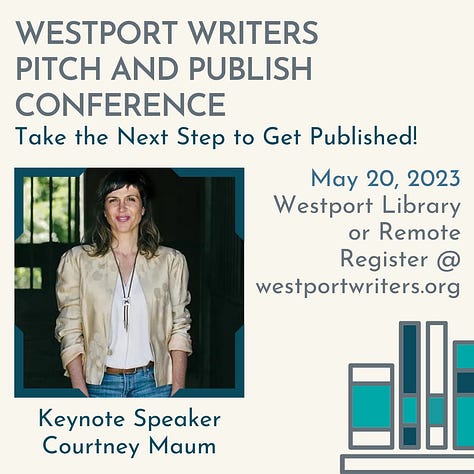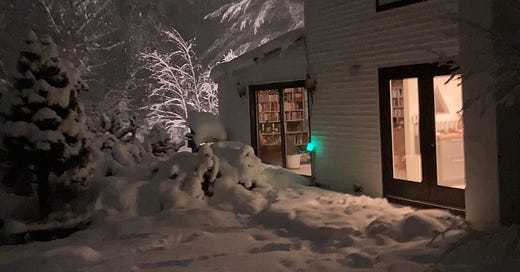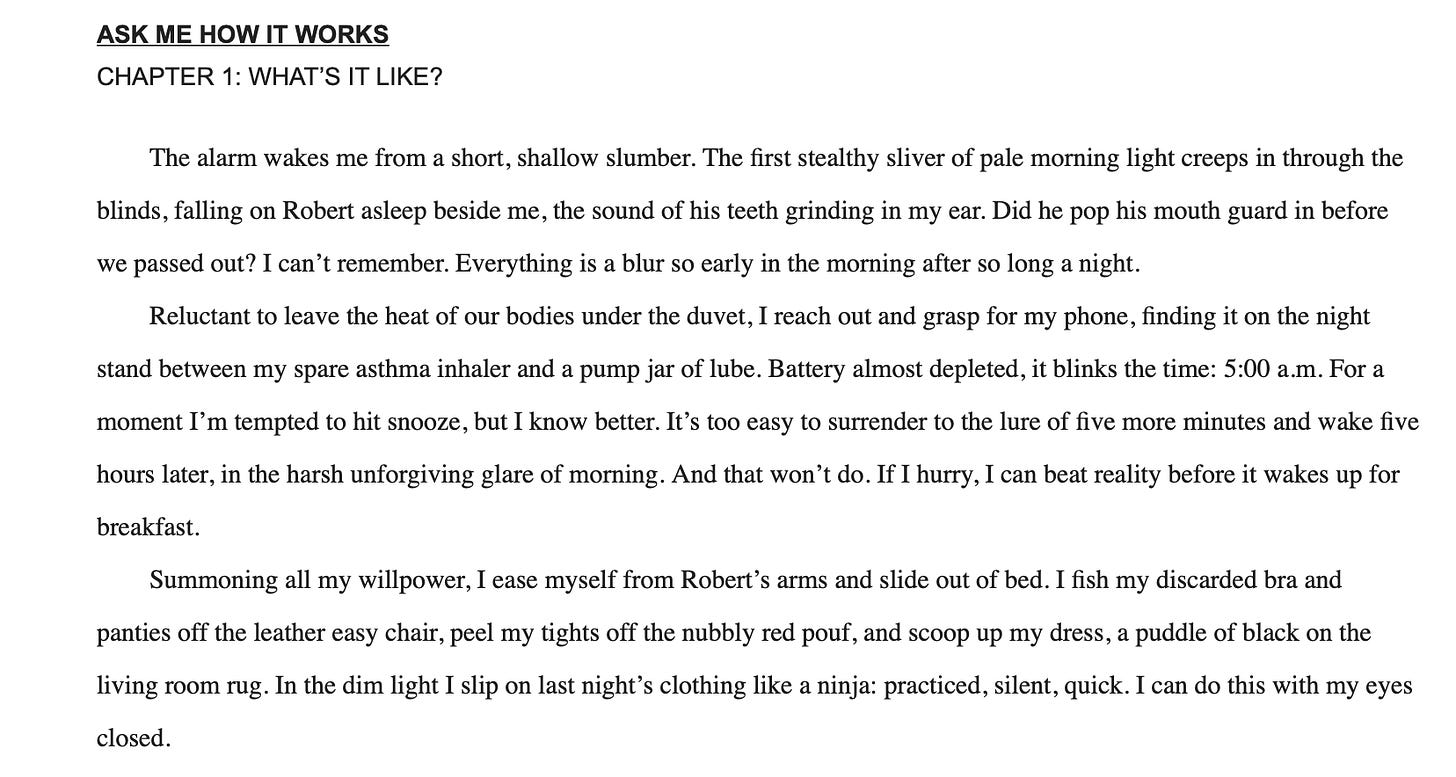Opening Pages - Subscriber workshops Part 1
Feedback on your pages - Literary fiction/nonfiction - Humor (mostly)
Friends, I have BEEN THROUGH SOME STUFF this week! My town was slammed by the Nor’Easter, and my modest dead-end lane (which is usually a boon because: privacy) became a negative when three downed power lines made it impossible for the plows to get through. Eversource said since the bottommost cable was the telephone line, that it was the telephone company’s responsibility. The telephone company said it was Eversource’s problem. Eversource said to call an electrician or 911. I apologized when I called 911 (Eversource made me!), and 911 said to call Eversource. All of this resulted in us being totally snowed in and barred from the back end of our domicile where the live wires were touching our house and trees.
We ended up having to shovel ourselves out and so I am writing this having lost about a zillion calories in physical effort. Which is why I’m picking subscriber examples in the humorous realm today to workshop. I need a pick-me-up!
As a reminder, the feedback below pertains to Week 1 of our Opening Pages intensive: Establishing setting in literary fiction and nonfiction. We got tons of submissions in this category—today we’ll be looking at four that fall (with one exception) into the humor category. Two are right on the money in terms of establishing a setting, the other two are just a few cents short. Let’s find out why!
Note: We are closed to further submissions for literary fiction/nonfiction setting. Thank you to everyone who sent work in.
Literary nonfiction setting example #1: When your book title supports your opening
Do you remember on Wednesday where we looked at how the book title GONE GIRL helped prepare the reader for the information and atmosphere we got in the first page of Gillian Flynn’s mega bestseller?
This delightful submission from our subscriber Deepa works in a similar fashion. It’s from her memoir titled “Ask Me How It Works: Frequently Asked Questions About My Open Marriage.”
If we didn’t have this revealing book title, Deepa’s opening page might hit differently. With the title, we start this book with expectations, nosiness, some questions. Let’s look how setting is working in Deepak’s opening:
Where are we: We are in bed. It’s the morning, and our narrator hasn’t had a lot of sleep. This is communicated by a brilliant opening sentence: “The alarm wakes me from a short, shallow slumber.” This person has to get up for some reason (hence the alarm) and they have had a short sleep (for some reason.) I’m intrigued to find out why their sleep was short and what they have to get up for, are you?
What’s special about this setting: What’s really working here is that Deepa has created tension between the unglamorous mundanities of marriage/long term relationships (mouth guards, inhalers, jars of lube, alarm clocks) and the erotic suggestions of clothes that have been discarded (and the lube, which becomes sensual in this context). Because of the enticing book title (“Ask Me How It Works: Frequently Asked Questions About My Open Marriage”) as a reader, we’re trying to sort out: is this the narrator’s husband that she’s with, or is it a lover? My guess, because of the intimate daily objects (the mouth guard, the inhaler) that we’re with the husband.
Where’s the heat: The heat starts with the title, and it continues to burn because Deepa is instilling sensuality and mystery into an otherwise run-of-the-mill situation (wife wakes up next to husband because of her alarm).
Why are we hooked?: How/when did this married couple open up their marriage? Just how open is it? Do they still have intercourse? When is this intercourse happening with other people? As the author imagined, we are left with lots of questions we want to ask, which means we want to turn the page. Win win for everyone!
Literary fiction setting example #2: Upending expectations
Our second subscriber example is from Katie— Katie doesn’t have a title for her novel-in-progress yet. Let’s apply the same questions we used for Deepa to Katie’s opening paragraph(s):
Where are we: We are in a yoga studio, where our narrator (or the narrator of this section) is about to start her second-to-last yoga class. When I first read this, I understood the narrator Cindy to be the instructor of this class, because my brain wanted her to be teaching her second-to-last class for a mysterious and maybe even petty reason, but on subsequent readings, I realized that Cindy is a student. And a disgruntled one.
What’s special about this setting: Much like in Deepa’s example, this setting is succeeding because our expectations about the space are overturned. When I think yoga studio, I think: presence, clarity, sanity, health, and I think, expensive. But this setting shows us a yoga studio that is grimy, hectic, and filled with the detritus of daily life. This contradiction makes us want to read on.
Where’s the heat: The heat starts building from the paradoxical setting, but it really kicks in with paragraph two, where we learn that Cindy just lost her job.
Why are we hooked?: We are on the brink of change here. Cindy has lost her job. I doesn’t matter to me that I don’t know what her lost job is yet— what matters to me is finding out whether the wool is falling from her eyes in other dimensions of her life. Like, she’s seeing her yoga studio for what it truly is, is that going to start happening with her friendships? Her dog, maybe? Someone she’s married to or dating? Her whole life? I want to read on to find out!
We’re now going to transition to look at focus in our settings: How can we help our readers understand where the heat is in a story?
Examples three and four share something in common. They’re both beautifully written, and promise something exciting from the opening page, but then they start veering away from that promised promise, which is a risky thing to do.
Let’s watch how and why.
Literary fiction setting example #3: If you’re going to lead with the lede, don’t bury it
This example is from subscriber Debbie, from her novel “Hands Free.”
Where are we: We are in a kitchen (we know this from “Out the kitchen window”) where a person named Alyssa Stern is squeezing royal icing onto parchment paper to practice her design for Lyssa Bakes’ first “wedding project.” A few things here. It might be all of my snow shoveling, but it took me three reads to realize that “Lyssa” is short for “Alyssa” and that “Lyssa Bakes” is the name of Alyssa’s company. For my first two reads, I thought that Lyssa and Nicole Turner were two different clients. I’d suggest two tweaks in order to make it clear that
1) this is Alyssa’s first client and
2) Alyssa is Lyssa.
Something like “Alyssa was so nervous about her first client project for her company Lyssa Bakes, that she woke up at the crack of dawn to practice…” or “She’d named her company after her mother’s pet name for her, Lyssa, and how she wished she had her mother here with her for her first client cake.” Personally, I always opt for clarity in opening pages, especially if you are getting ready to query.
What’s special about this setting: It’s notable that with the success of televised baking programs, there aren’t a lot of books written from the POV of pastry chefs and bakers. (Chocolat springs to mind, but that’s 23 years old!) Accordingly, this opening feels like we’re being taken behind the curtain into a titillating world. Alyssa is a professional, but she’s nervous here, she is practicing. We don’t often think of pastry chefs as people who practice, like a pianist might, so this scene feels special. We are witnessing something.
Where’s the heat: It’s in line 1! “Twelve hundred cookies stood between Alyssa Stern and the end of her marriage.” What a great beginning—a beginning for the ages. Does Alyssa need to fulfill a baking contract in order to hire a lawyer, or pay for a divorce? Or does she not even know that her marriage is about to end, and this is an omniscient voice we’re hearing? Regardless, we want to know why her marriage is ending (and why there are 1200 cookies in the way of that marriage ending?)
Why are we hooked?: I want to be hooked, but by the end of this page, I’m starting to get frustrated. All we need is an extra little crumb about why/how this marriage is ending in this first page, and then the narrator can go on all she wants about her first client, Nicole. But because the marriage-ending info is dangled like a carrot in the first line and not brought up again on the first page, I feel a little tricked. It truly wouldn't take a lot to win my loyalty back, though, because the setting and this woman’s profession has my interest. Just a hint at the existence of this lady’s spouse, and I’m back in. For example: “Out the kitchen window, pre-dawn’s navy skies gave way to streaks of pink and purple over the mountains—it’s a view that Robert claimed he used to love, until he moved 5000 miles away from it for ‘work.’”
Because I don’t know what happens in the following pages, I can only conjecture as to why the marriage is ending. But what I do know is there is a disproportionate amount of text focusing on this new client, Nicole, when what we really want is more hints about the crisis at hand.
Literary fiction setting example #4: Instilling subjectivity into settings
Our final example for this week comes from subscriber Katie from what I assume is a novel (I wasn’t given the book title or genre). Unlike myself (remember, I admitted that I’m terrible at landscape descriptions), Katie excels at descriptive writing. I felt chilled to my bones in the first paragraph.
So much is working here. The landscape is hyper specific, we are told exactly what we’re looking at. It takes a beat to understand where Gemma is walking and why: she’s a writer/journalist en route to interview a man named Jerry who will be turning a former school into luxury apartments.
How does Gemma feel about this? Did she attend that school? Is she new to the area? Did she grow up there? If she’s new to the area, she might not feel the same about the condemned school as she would if she were local. What we’re missing in this opening is subjectivity: we are seeing the setting through a movie camera, not through Gemma’s eyes.
Setting can be written in a neutral, omniscient manner when a location is the main character, but I’ve got a hunch here that most of this book will be following Gemma, so we need to see this world through Gemma’s point of view. I love the description at the end of the neglected building and the trash piling up, which threatens to be pushed all over the place in the ceaseless wind. But what about Gemma? Is she neglected? What social class does she belong to? What age is she? Is she single? Is she nervous? What’s her resting heart rate? What kind of milk does she drink, if she drink’s milk?
Setting is our ally in character development when we write it through the eyeballs of the character in question. Just a few examples (for fun) on how to get more of Gemma into this first paragraph. Each sentence starts with something Katie has actually written, and then adds a little something that would give us insight into Gemma’s character.
It was the Tuesday before Thanksgiving and the wind whipped cold off the lake, across the empty shoreline of Bradford Beach, and all the way up to the old water tower atop the hill where Gemma Murphy had once played spin-the-bottle with her now ex-best friend.
It was the Tuesday before Thanksgiving and the wind whipped cold off the lake, forcing Gemma Murphy to tighten the thrift store scarf she’d managed not to lose in three Milwaukee winters tighter around her neck.
It was the Tuesday before Thanksgiving and the wind whipped cold off the lake, across the empty shoreline of Bradford Beach, and all the way up to the old water tower atop the hill. Gemma Murphy didn’t have time to be doing this interview. Her Aunt needed cranberries, and not the canned kind. What other kind was there?
It was the Tuesday before Thanksgiving and the wind whipped cold off the lake, across the empty shoreline of Bradford Beach, and all the way up to the old water tower where her intolerable editor claimed he’d once got to third base. From where she was standing, Gemma could already spot the sad-looking trailer where she’d conduct her interview. This was the weird thing about big wigs in real estate development: their offices were shit.
The above game out an opening that builds on the strong foundation that Katie has already laid for it, with more intimate bricks. This is a solid piece of writing, and unlike many things I read in my teaching and coaching life, it respects the reader by letting us know exactly where we are in time and space. We just need to know a little more about the fictional person guiding us there—and then we are all in.
I’m super grateful to our four subscribers for going first in our Opening Pages Intensive—Feedback edition!. There will be more examples from subscribers coming soon. If you’d like to participate by sending your own pages in the next time we have an open call, remember to upgrade. Friday workshops are only for paid subscribers.
I have so many fun public events on the docket this spring. Here are some of my faves.






April 1st I’m at the Woodstock Bookfest in a Memoir-a-Go-Go panel with some heavy hitters. Info here!
April 4th I’m in Chicago to raise money for Story Studio Chicago— a community writing center. I’m giving a lecture about fear, followed by a conversation with our own lady of literature, Rebecca Makkai, followed by snacks! Single tickets and discounted group rates available. Info on my events page.
April 22 I’m teaching online at the HerStory Conference about everything no one else will tell you about publishing— there are incredible writers and thinkers teaching online that day with me. Find out everything here.
On May 6th why you would want to do anything other than join me, Roxane Gay, Carmen Maria Machado, Matthew Salesses and others? Check the conference out and see if you can join. All info here.
May 20th I’m in Westport, CT for a Pitch and Publish conference where you will learn a lot! The lineup is here.
As always, thanks for being here!
xoxo
Courtney










Holy cow, Courtney, thank you! I was worried the 1200 cookies explanation came too late, but didn't even notice I buried the actual lede. You're right, it's (I think) a simple fix:
Twelve hundred cookies stood between Alyssa Stern and the end of her marriage.
After so many years, the pastry bag felt like an extension of her body. She held it with confidence, the way a concert violinist wields a bow. The smooth, taut plastic slackened as she squeezed elegant swoops and swirls of royal icing onto a piece of parchment paper. These new flourishes matched the two dozen she’d already laid down. Perfect. She paused to admire her work, let the icing’s familiar lemon scent ground her.
Out the kitchen window, pre-dawn’s navy skies gave way to streaks of pink and purple over the mountains. Resentment flickered in Alyssa’s chest when she noticed the dark windows in the backyard Airbnb, Jeremy’s temporary quarters. He must be sleeping in. Again. When was the last time she slept past seven on a school day? This morning, nervous energy had awakened her early to practice for the first wedding project she’d landed for her company, Iced by Alyssa. The bride signed off on the prototype yesterday. Alyssa had felt fizzy all night, as if champagne replaced the blood in her veins.
Somehow, she’d convinced Nicole Turner, daughter of the area’s top philanthropist, to use 3D, tiered wedding cakes made of elaborately iced cookies as centerpieces at her New Year’s Eve wedding, just ten weeks away. The day Nicole announced her whirlwind engagement on Instagram, Alyssa messaged her the sketch of an idea she’d been toying with for years. The bride had swept into the bakery like a Gen Z Catherine Deneuve, all pushed-up sunglasses, gleaming blonde hair, and luminous, unlined skin. With a good twenty years on her, Alyssa felt distinctly troll-like in her presence. Nicole was too busy being glamorous to notice.
It took several weeks of back-and-forth, with each sketch a little more complicated than the previous one, before Nicole signed the contract. Alyssa still couldn’t believe her moonshot worked. This high-profile gig—some twelve hundred cookies with place cards, dessert, and favors figured in—might launch her business from a small town in the western Catskills all the way back to the city, even beyond. It made one thing clear: Jeremy went to art school, but in the end Alyssa’s artistry would support the family. Support her and Gertie.
Courtney, you absolutely made my week! Thank you so much for your comments on my opening pages. Really loving this intensive so far, and looking forward to what’s to come.